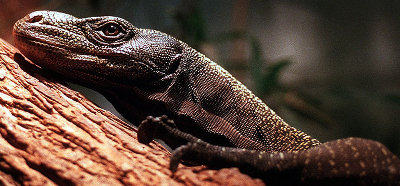Crocodile Monitor Lizard
Category: Lizard

Facts about Crocodile monitor. "Scientific name for is Crocodile monitor is Varanus salvadorii". Crocodile monitor is a type of lizard found mostly in New Guinea and it is also known by other different names such as; Salvadori’s monitor, artellia and Papua monitor. Crocodile monitor is known to be one of the longest lizard in the world. It can grow as long as 244 cm (96 inches) or more. Crocodile monitor lizard can grow longer than the world’s longest lizard, the Komodo dragon. Its length is however, attributed to a tail that is almost twice as long as the body. Varanus salvadorii is an arboreal lizard. Crocodile monitor has a dark green body and yellow bands, with a blunt snout. It lives mostly in mangrove swamps and in coastal rain forests.
Crocodile monitor lizard has anatomical features that enable it to breathe more easily while running than other lizards. This is due to a positive pressure gular pump in its throat that enable lungs ventilation while running. Crocodile monitor may have greater stamina than other lizards. It has unique characteristics that differentiate it from all other lizards. The Crocodile monitor include its green body its yellow ring-like spots, its long tail that is more than twice the length of its body from snout to vent, its long straight teeth and prominent curved claws.
The Crocodile monitor lizard can hang on to tree branches with its rear legs. It occasionally uses the tail as a prehensile grip. Their long tail is meant to counterbalance its body weight while leaping from branch to branch. The tail is also used for defense. The Crocodile monitor lizard mostly like to bask on tree branches, but also bask and sleep on the ground. They also submerge in water. The Crocodile monitor lizard occasionally arise on their hide legs to check on their surroundings. It avoids human contact. Its bite could be fatal. And may lead to death. In 1983, a Papuan woman died from a crocodile monitor bite.
Crocodile monitor lizard have unique teeth. Its teeth are sharp unlike other monitors which have blunt teeth. Its upper teeth are long, fang-like and stand vertically from the jawbone. The Crocodile monitor lizard are designed to hook into fast moving prey and hold it. Their lower teeth are shorter and are housed in a fleshy sheath and it is a top predator in New Guinea. The Crocodile monitor lizard feeds on birds, eggs, small animals and rodents. Those that live in mangrove forests and swampy areas are known to eat frogs and fish. Captive specimens feed on chicken, fish and dog food.
Not much is known about crocodile monitor’s reproduction. No reproduction has been observed in the wild. It has only been observed in captivity. Crocodile monitor lizard lay a clutch of eggs that comprises between four to twelve eggs. Their eggs are deposited between October and January.. The eggs differ in size. Most of the eggs laid in captivity have been infertile. Their hatching is about 17 3/4 (45 cm) long. The hatching is more colorful than adults.
Crocodile monitor lizard is hunted by tribesmen. It is skinned alive and its skin used to make drums. They describe it as an evil spirit which climbs trees. It is however maintained that gives warning when there are crocodiles nearby.
Crocodile monitor lizards are intelligent reptiles. They pay much attention to their environment. The Crocodile monitor lizard focus their attention to any movement around them.

 Back To Category Lizard
Back To Category Lizard